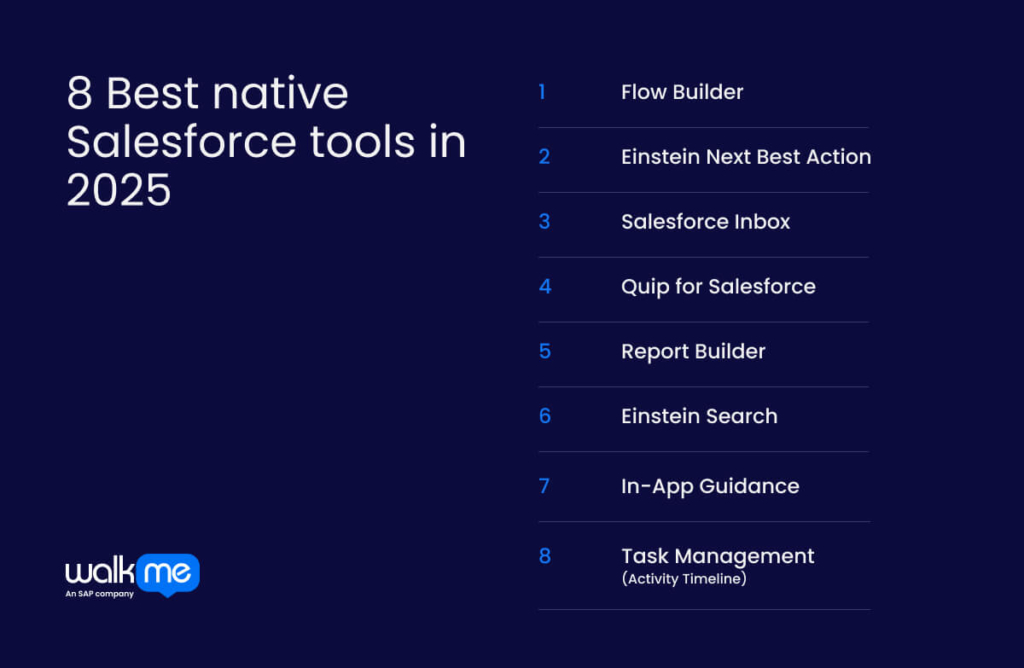Salesforce offers businesses numerous tools and features, but selecting the right ones can be a daunting task. Many teams struggle when they don’t set clear goals or define the enterprise transformation they need.
Without that focus, they often waste time and money on tools that don’t meet real needs. To avoid this, teams should first identify their business goals and understand where Salesforce can add the most value.
This article provides you with a list of top Salesforce tools—both native and third-party that your business could adopt. These tools can support key goals, such as automation, enhanced teamwork, data analysis, and improved user experience.
8 Best native Salesforce tools in 2025

Native Salesforce tools are apps made within the Salesforce platform using its code and features. They offer benefits such as enhanced security, real-time data access, and seamless integration with Salesforce.
So, take a look at these options before looking at third-party integrations:
| Category | Tool | Description |
| Automation & Workflow | Flow Builder | Drag-and-drop tool for creating workflows like sending emails, updating records, and automating tasks. |
| Einstein Next Best Action | AI-powered recommendations for next steps based on user behavior, built using Flow Builder. | |
| Collaboration & Knowledge | Salesforce Inbox | Integrates email/calendar with Salesforce to track engagement, log emails, and book meetings. |
| Quip for Salesforce | Collaborative document editing and communication tool integrated into Salesforce. | |
| Data & Reporting | Report Builder | Interface to create custom reports using drag-and-drop, filters, and grouping. |
| Einstein Search | AI-powered search with natural language support, previews, and direct actions. | |
| User Engagement & Guidance | In-App Guidance | Prompts and walkthroughs within Salesforce UI to guide users and drive adoption. |
| Task Management (Activity Timeline) | Timeline view of tasks, events, and emails linked to Salesforce records for easy tracking and updates. |
Automation and workflow tools
Salesforce’s built-in automation tools can simplify business tasks and increase efficiency. They automate repetitive work, reduce errors, and enable teams to make faster decisions.
Moreover, these tools save time, allowing sales teams to focus on customers and key goals.
So, these are the native tools that will allow you to focus on more strategic work:
- Flow Builder
Salesforce Flow Builder enables users to build automations using a simple drag-and-drop interface. Users can create workflows to send emails, update records, or connect apps.
Additionally, it supports various tasks, including managing leads, handling support, and cleaning data. Flow Builder works across Salesforce apps, making it easy to streamline processes.
- Einstein Next Best Action
Einstein Next Best Action in Salesforce uses AI to suggest actions or offers based on user behavior in the CRM. Sales reps or customers choose to accept or reject them. Salesforce then triggers follow-up steps. Users build strategies using tools like Flow Builder through a simple, easy-to-use interface.
Collaboration and knowledge sharing tools
Collaboration and knowledge-sharing tools in Salesforce enable teams to communicate, share files, and manage information in a single location.
These tools enhance teamwork, streamline workflows, and enable teams to make informed decisions that drive business goals.
These are the tools you need to adopt:
- Salesforce Inbox
Salesforce Inbox integrates email and calendar tools with Salesforce, enabling sales teams to stay organized. Users log emails, track engagement, and schedule messages. They can also share availability, book meetings, and create records directly from their inbox.
- Quip for Salesforce
Quip helps teams edit documents and send messages without switching tools. This is because it connects directly to Salesforce.
Teams also create custom templates and add tools, such as Kanban boards and trackers, to their documents. With Quip, teams such as sales, marketing, and service can manage plans, track progress, and follow clear steps, all in one place.
Data and reporting accelerators
Salesforce’s built-in data and reporting tools provide users with a straightforward way to view and understand data in one place.
For instance, they enable users to create custom reports, identify trends, and track key metrics. Additionally, these tools provide real-time insights and store all data within Salesforce.
Here are the in-built features in this area you might find helpful:
- Report Builder
Salesforce Report Builder enables users to create and customize reports using a simple drag-and-drop interface. Users choose fields, apply filters, and group data to highlight key insights. They select from formats such as tabular, summary, matrix, or joined to display their data best.
Additionally, users can export reports or share them with their teams for enhanced collaboration and productivity. Report Builder also allows users to run reports in the background, keeping work moving smoothly without delays.
- Einstein Search
Einstein Search utilizes AI to enhance how users locate information in Salesforce. It supports natural language so that users can type full questions instead of keywords. The search results display previews, quick links, and action buttons, allowing users to take immediate action directly from the results.
Additionally, service agents use it to locate relevant knowledge articles quickly. Einstein Search integrates with other Salesforce AI tools and is available in Lightning-enabled Enterprise, Unlimited, and Performance editions. It learns from each user’s activity to deliver better results over time.
User engagement and guidance tools
User engagement and guidance improve how people use Salesforce by helping them learn features and complete tasks more easily.
These tools provide tips based on users’ actions, helping them work more efficiently and accurately. Furthermore, they enhance productivity and increase user satisfaction with the platform.
Here are examples of these native tools:
- In-App Guidance
Salesforce In-App Guidance helps users learn and adopt the platform by showing prompts and walkthroughs directly in the Lightning Experience. Salesforce administrators can create this relevant guidance to explain steps or offer helpful tips on specific pages or apps.
Furthermore, employees can access contextual help directly where they work. This support addresses the skills gap and accelerates user adoption across the team, eliminating the need for additional training sessions.
- Task Management (Activity Timeline)
Salesforce Task Management, also known as Activity Timeline, provides users with a clear view of all tasks, events, and emails. These can be linked to records, such as accounts or opportunities. Users can quickly spot upcoming and overdue activities, helping them stay on top of their work.
Additionally, they can filter the timeline by type or date to focus on specific key actions. The timeline lets users open, update, and complete tasks without leaving the page.
6 Best third-party Salesforce tools in 2025

Third-party Salesforce tools offer specialized features, increased flexibility, and seamless integration with other systems.
Additionally, they enhance Salesforce by improving data handling, automating tasks, and facilitating more effective team collaboration.
Let’s look at these different types of tools:
| Category | Tool | Description |
| Automation & Integration | Tray.ai | Visual workflow builder to connect Salesforce with other apps and automate data syncing. |
| Workato | Integration platform using “recipes” to automate processes between Salesforce and other tools like Slack, NetSuite, and SAP. | |
| Collaboration & Communication | Slack | Messaging platform integrated with Salesforce for real-time collaboration, record sharing, and alerts. |
| Aircall | Cloud-based phone system for making and logging calls directly in Salesforce, integrated with Omni-Channel. | |
| Data Visibility & Reporting | Conga Grid | Grid-style interface for viewing and managing Salesforce records with batch actions and Excel-like tools. |
| Cloudingo | Data quality tool that finds, merges, and fixes duplicates, validates and imports clean data into Salesforce. |
Automation and integration tools
Third-party automation and integration tools on Salesforce enable businesses to automate tasks, connect with other systems, and gain a clear view of customer data.
These actions improve employee productivity, efficiency, and decision-making.
Let’s delve into tools that you could adopt:
- Tray.ai
Tray.ai helps Salesforce users connect their CRM with other apps through a cloud-native platform. Users build custom automations with a visual workflow builder, such as creating task lists. Tray.io also syncs data in real time, keeping information accurate across all tools.
Moreover, it supports integrations with various apps, including RingCentral, Segment, Asana, and many others. Users control how they connect systems, tailoring each workflow to their team’s needs.
- Workato
Workato connects Salesforce with other business applications, enabling users to automate tasks using simple ‘recipes’. These recipes trigger actions, such as sending a lead to marketing or creating a support ticket when a case is opened in Salesforce.
In addition, Workato keeps customer and sales data synced across systems, such as updating Salesforce from an ERP or HR tool. Lastly, Workato also integrates with various tools, including Slack, NetSuite, Workday, and SAP.
Collaboration and communication add-ons
Collaboration and communication tools on Salesforce enable teams to work more effectively together. They facilitate communication, enhance workflow efficiency, and foster a more positive customer experience.
Here are the ones you need to be aware of:
- Slack
Slack integrates with Salesforce to connect with the Customer 360 ecosystem. It works with Salesforce’s Sales Cloud, Service Cloud, and Marketing Cloud. Users can view and interact with accounts, opportunities, and cases within Slack.
Furthermore, Slack enables real-time communication, facilitating seamless collaboration and the sharing of updates. It allows users to search for and share Salesforce records, as well as set alerts for important updates. Then, Slack automates workflows, such as updating CRM records or sending notifications.
- Aircall
Aircall integrates with Salesforce as a cloud-based phone system, allowing sales teams to make, receive, and log calls within Salesforce. Additionally, Salesforce agents can initiate calls directly from the Work Queue in Salesforce.
Aircall works on web, desktop, and mobile apps, giving teams flexibility. It syncs call data automatically with Salesforce, improving accuracy. Furthermore, it integrates with Salesforce’s Omni-Channel feature to manage all customer communications.
Data visibility and reporting tools
Data visibility and reporting tools within Salesforce help ensure data accuracy and consistency across systems.
Furthermore, it provides better customer insights and facilitates the development of cross-functional teams. These connections help reduce data gaps, expedite tasks, and inform better decisions.
Here are our top picks:
- Conga Grid
Conga Grid helps users manage Salesforce data through a simple, grid-style interface. It replaces standard Salesforce lists with a view that lets users see, edit, and update records in one place. Users save time by avoiding the need for multiple tabs and screens.
Next, Conga Grid also enables users to perform batch actions and utilize Excel-like tools for enhanced data control. It integrates with other Conga tools, such as Conga Composer and Conga CLM, to expand its features.
- Cloudingo
Cloudingo helps businesses maintain clean and accurate Salesforce data by identifying and merging duplicate records. It checks data for errors, patterns, and missing information. Users import data from various sources and transfer it between Salesforce systems with fewer errors.
Additionally, Cloudingo offers tools to filter, update, delete, and validate data. It also allows users to automate tasks such as deduplication and data imports, saving time. The platform gives real-time reports to track data quality and spot issues.
Maximize productivity with a suite of native and third-party Salesforce tools
Salesforce tools help businesses improve efficiency and stay competitive. To get the most out of these tools, review your manual processes and map them out to find where automation can save time and reduce errors. Build clear, streamlined workflows instead of overlapping ones to keep systems easy to manage and maintain.
When integrating with external data sources, utilize scheduled actions to enhance control and minimize issues. Plan your Salesforce adoption with growth in mind by using modular, reusable components. This approach makes it easier to update or expand your processes as your business grows, without needing a full system redesign.
FAQs
Salesforce tools are digital apps that help you manage customer relationships, automate tasks, and create custom apps for your business.
Salesforce tools are essential because they enable sales, marketing, and customer service to work faster and more efficiently. This helps teams accomplish more and keeps customers satisfied. These tools also grow with your business, work well with other apps, and can be used on mobile devices.

